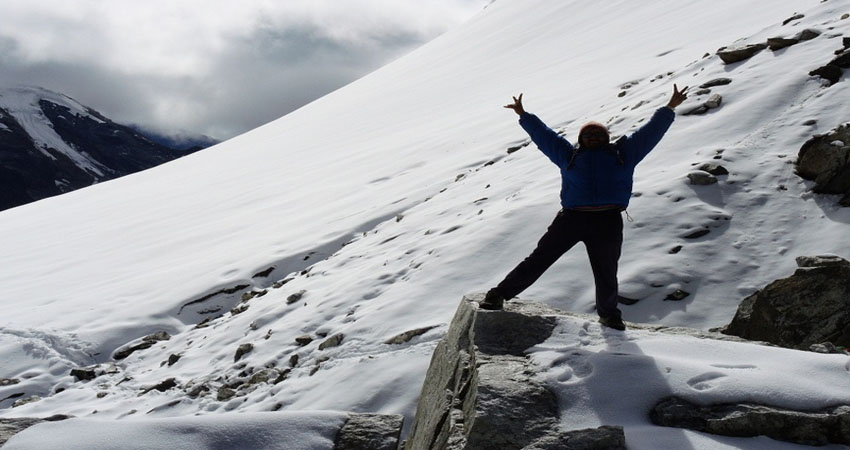Best Trekking Season in Nepal
The Spring Season- March to April
Spring begins in March and lasts until April. Nepal trekking is second busiest time of the year, especially in the Everest and Annapurna regions. This time, day time temperatures are warm to hot and the days are longer. March and April mark the transition from winter to summer in Nepal. The trails up to the tree line ablaze with blooming rhododendrons, hill sides are adorned with vibrant colors, seen magnificent landscapes against the backdrop of the Himalayas; the sky is clear and shown excellent visibility of the snow-capped peaks throughout the trek. Between March and April, it’s considered with much cultural festival, adding an extra dimension to your trekking experience. And it tends to be less crowded compared to the peak season of autumn. So, it’s opportunity to enjoy the trails and accommodations with fewer trekkers, allowing to you peaceful experience. The trails are usually dry and more stable during spring season.
Temperature in upper hill and lower mountain ranges reach 16-230C.
The Autumn Season- mid October to mid December
October and November is the peak trekking months in all of trekking areas of Nepal. These months have pleasant with clear skies, mild temperatures and low precipitation. During this time, trekkers allowing admiring the majestic all peaks in all their glory. In addition, trekkers in autumn are treated to vibrant landscapes adorned with colorful foliage. The conditions of mild temperatures and stable weather make trekking comfortable and enjoyable. Trekkers can cover longer distances each day without having to contend with extreme cold or heat. Trekkers have the opportunity to meet felloe adventurous from around the world, share stories and forge lasting friendships. The nights are cool but not uncomfortably cold and the days are pleasantly warm for trekking. October to December is also festive time; the most prominent festival is Dashain, Nepal’s biggest Hindu festival. Participating in these festivals can provide with unique cultural experiences and insights into Nepalese traditions. More, trails are typically dry and well dell-defined, reducing the risk f mud and landslides that can occur during the monsoon season.
Temperature in upper hill and lower mountain ranges reach 15-240C.
The Winter Season – mid December to mid February
The coldest time is mid-December through February in the Himalaya with temperatures falling we’ll below zero- especially at night and higher altitudes. January is too cold for trekking: however, it is possible to trek in trails. Winter in Nepal brings clear skies and crisp, fresh air and the landscapes transformed into a winter wonderland. It offers a unique beauty, with snowcapped mountains, frozen waterfalls and icy streams creating a magical atmosphere. Winter is considered the off-season for trekking in Nepal, which means you’re likely to encounter fewer trekkers on the trails. Temperatures can drop well below freezing and snowfall is common, in the high pass and mountainous regions. Some of the popular trails like Everest Base Camp, Langtang valley, Helambu Circuit and Annapurna – is possible which does not involve high passes and trails are less affected by snow. Winter is a quieter time in Nepal, allowing for more meaningful interactions with local communities, experience authentic Nepalese hospitality, traditional lifestyles and rich cultural heritage of the region. Trekkers need to be prepared for cold temperatures, icy trails and the possibly of encountering snowstorms.
The Monsoon- July to September
During the monsoon season, which stereotypically lasts from June to late September presents both challenges and opportunities fro adventurous travelers. This season in Nepal brings heavy rainfall with temperatures high. The trails can become muddy and slippery making hiking more challenging and potentially hazardous, particularly in steep and rocky sections. Monsoon clouds often observe the views of the majestic Himalayan peaks, reducing visibility, encounter foggy conditions and misty landscapes.
Despite the challenges, trekking during the monsoon season offers the Nepal’s lush green landscapes in their full glory and the trails are more serene and peaceful atmosphere with few trekkers. During this time, there are several festivals and religious including Teej, Gai Jatra and Krishna Janmastami. Budget-conscious travelers may find better deals and discounts on lodging and services.
Final Say
Overall, all the seasons are best for trekking but these are most operate seasons the trekkers visit. These seasons offers a favorable weather conditions and spectacular scenery, making ideal for trekking adventures in Nepal. However, it’s essential offering a perfect balance of favorable weather, fitness level, and the plan of the specific region you visit when deciding the best time for trek.
